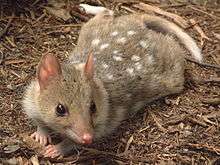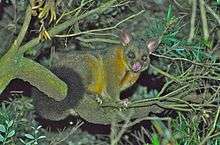Waitoreke
In New Zealand folklore, the waitoreke (or waitoreki, waitorete) is an otter/beaver-like creature. It is usually described as a small otter-like animal that lives in the South Island of New Zealand. There are many theories on the waitoreke's true identity, such as it being an otter, beaver or pinniped.
| Other name(s) | Maori otter, New Zealand otter |
|---|---|
| Country | New Zealand |
| Region | South Island |
Etymology
The origin of the name "waitoreke" is not well documented; it may have been an invention. It does not occur in Tregear's fairly comprehensive Māori dictionary of 1891, and was said to be "ungrammatical" by leading Māori anthropologist Te Rangi Hīroa.
Despite this, etymologies have been put forward by researchers:
- "Wai" is from the Māori word water. This is generally agreed upon; wai or variations thereof are the universal term for "water" in Polynesian languages (Tregear 1891).
- One of the theory is that "to reke" translates to "the (bone) spurs", i.e. "waitoreke" = "water (animal with) the spurs". Reke is a specifically Māori term denoting a spear thrust or hair that has been tied into a protruding knot (Tregear 1891).
- Toreki is South Island Ngāi Tahu dialect (see also Mantell account below) of "torengi", and sometimes taken to mean "to disappear". Thus "waitoreke" = "disappears (into) water". According to Tregear (1891), torengi might conceivably used signifying "to disappear", but the disappearing act has to be due to being left behind by someone. The meaning may have changed with the dialect; the alternate translation "water (animal) that was left behind by someone" (i.e., introduced by humans) is as plausible (or implausible).
- Wai means "water", the following syllable to links the word to the spiritual world and the rest of the word means "to disappear". Therefore, the translation might be "a disappearing water spectre" (Becker, 1985; cited in Mareš, 1997) - for the Māori it was the most common animals which played significant roles in their lives, unlike Europe, where the criteria for turning an animal into a mythological creature was its rareness.
- A final one is that "toreke" may be a distortion by the Māori of a foreign (Asian/Arab) name for the animal.
Since European settlement (late 18th century onwards) the animal has also been referred to as the "New Zealand otter", "Māori otter", "New Zealand beaver", "New Zealand muskrat" and "New Zealand platypus" based on various accounts and theories.
Description


The waitoreke is usually described as a small otter-like creature sometimes as big as a cat. It is described as having brownish fur and short legs. The sightings usually place the creature near or in the water on the South Island of New Zealand. Its fur is described as being short like that of an otter.
Very little physical evidence proving the existence of the waitoreke exists. Julius von Haast is reported to have obtained a waitoreke pelt in 1868. The fur was brown, with white spots, and the toes lacked webbing. This is inconclusive evidence; the pelt seems to have resembled a quoll's. The common brushtail possum was successfully introduced in 1858 and is now a widespread pest, whereas introduction of the common ringtail possum ultimately failed. Both animals are unspotted.
Sightings
Evidence for the existence of the waitoreke is mainly based on sporadic accounts of an "unidentified amphibious animal" in the country's South Island spanning well over 200 years. Areas vicinity to Otautau had more records.[1] Some of the more infamous accounts are dubious and/or incongruous - but a significant number of descriptions (particularly from the late 19th century onwards) share a striking similarity to each other and to species known to exist outside New Zealand. The Māori people said that in old times they used to keep waitoreke as pets (Mareš, 1997).
Some of the most notable early (claimed) accounts come from pre-20th-century explorers/naturalists:
- Captain James Cook - Dusky Sound - 1772[2][3][4]
- Walter Mantell - various - first half of the 19th century(?), Temuka location: "He informed me that the length of the animal is about two feet from the point of the nose to the root of the tail; the fur grisly brown, thick short legs, bushy tail, head between that of a dog and a cat, lives in holes, the food of the land kind is lizards, of the amphibious kind, fish - does not lay eggs." Recorded in an interview with "Tarawhatta" (=? Arawhata) of the "Ngatomamoes" (= Kāti mamoe lineages of the Ngāi Tahu). The date is variously given as 1838 or 1848 in secondary sources.
- This description is strongly reminiscent of a common brushtail possum which despite being primarily arboreal sleeps in burrows or dens. It usually forages in trees but this is more subject to food availability than a genuine preference of this voracious and quite indiscriminate carnivore. They have wreaked havoc among New Zealand's unwary reptiles and (often semi-terrestrial) birds. While the introduced species seems a near-perfect match, it is not known to have been established until 1858; it was numerous enough to be encountered in many places from 1860 at the earliest.
- Reverend Richard Taylor - various - first half of the 19th century and perhaps earlier. In his 1855 book Te Ika a Maui.
- Julius von Haast - various - 19th century. As quoted in Alfred Brehm, Brehms Tierleben, chapter Monotremes: "Another interesting creatures among the most primitive mammals is the only indigenous New Zealand mammal, waitoteke (sic), an otter-like animal which has been seen several times, once from such a short distance that it was hit with a whip, but then it disappeared in the water with a very brittle sound. Jul. v. Haast saw its tracks in the snow. Yet no-one was able to catch the animal so far. It is thought that this mammal is more primitive than Monotremes and will put some new light upon the ascent of the class which ends with the Man." As quoted in Hochstetter's New Zealand: "My friend Haast wrote me about vaitoteke (sic) on June 6, 1861: ´3500 feet above the sea level I found, on the upper part of Ashburton river (South Island, Canterbury province), in a part of the country which no man has ever visited before me, its tracks. These are similar to those of an otter, only a bit smaller. However, then animal itself was observed by two gentlemen who own a sheep farm near Ashburton 2100 feet above the sea level. They described the animal as being dark brown, the size of a big rabbit. When hit with a whip, it made a whistle-like sound and disappeared in the water.´"
Later accounts come from a variety of settlers, farmers, trampers, hunters, tourists and scientists throughout the 20th century. Many of these sightings were assessed in a paper on the subject of the waitoreke by G.A. Pollock in 1974[5] which led to a search of the area around lakes Waihola and Waipori in Otago during the 1980s.
New Zealand mammals
The waitoreke would be most remarkable if it exists, due to the fact that New Zealand is one of the few significant land masses on Earth to have no recent native land mammals. The South Pacific nation does play host to several native pinnipeds (seals, sea lions) and bat species (genera Mystacina and Chalinolobus; several extinct genera are known from the earlier Saint Bathans Fauna[6]) but is most notable for its plethora of bird species that seem to have evolved without the restrictions of mammalian predation: flightless species that would have been fair game for any hunting mammal were most plentiful, and there were even some tiny flightless passerines - a thing almost unheard of, and certainly unknown in the presence of mammalian predators as small as shrews.
New Zealand's dearth of mammals is a result of its separation from the super-continent of Gondwana approximately 80 million years ago, in the Cretaceous period. Recent discoveries in an Otago fossil lake bed suggest that at least one terrestrial mammal species, the Saint Bathans Mammal, existed in New Zealand before human settlement.[7]
See also
- History of New Zealand
- Maero
- Maori language
References
- Lloyd Esler (30 November 2017). "Whale species discovery at Mason Bay, 1933". The Southland Times. Retrieved 2 December 2017.
- 1966 in An Encyclopaedia of New Zealand
- "...all the witnesses agreed that it was “about the size of a cat, with short legs, and of a mouse colour.” ..."
- https://www.gutenberg.org/files/15777/15777-8.txt "For three or four days after we arrived in Pickersgill harbour, and as we were clearing the woods to set up our tents, &c. a four-footed animal was seen by three or four of our people; but as no two gave the same description of it, I cannot say of what kind it is. All, however, agreed, that it was about the size of a cat, with short legs, and of a mouse colour. One of the seamen, and he who had the best view of it, said it had a bushy tail, and was the most like a jackall of any animal he knew. The most probable conjecture is, that it is of a new species. Be this as it may, we are now certain that this country is not so destitute of quadrupeds as was once thought.", James Cook, "A Voyage Towards the South Pole and Round the World", Volume 1
- Pollack, G.A. (1974). "The South Island Otter – An Addendum" (PDF). Proceedings of the New Zealand Ecological Society. 21: 57–61. Retrieved 4 July 2019.
- Worthy, Trevor; Hand, SJ; Worthy, TH; Archer, M; Worthy, JP; Tennyson, AJD; Scofield, RP (2013). "Miocene mystacinids (Chiroptera, Noctilionoidea) indicate a long history for endemic bats in New Zealand". Journal of Vertebrate Paleontology 33 (6): 1442–1448.
- "New Zealand's Indigenous Mouse". Retrieved 2 August 2007.
Further reading
- Brehm, Alfred, Brehmův život zvířat, IV/I (Brehms Tierleben), Prague, p. 83
- Tregear, Edward Robert (1891): Maori-Polynesian Comparative Dictionary. Lyon and Blair, Wellington. Online version 2005-FEB-16.